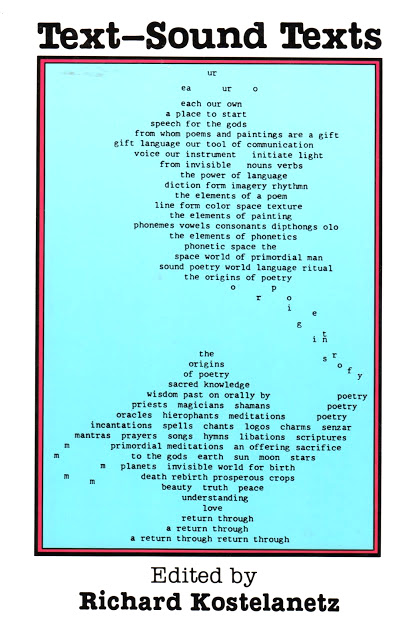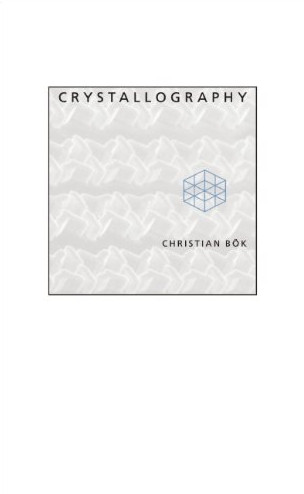Richard Kostelanetz (ed.): Text–Sound Texts (1980)
Filed under book | Tags: · avant-garde, composition, concrete poetry, language, performance, poetry, sound poetry

Anthology of scores, scripts, instructions, diagrams and documentation of art works that are meant to be heard. With more than one hundred pieces from a broad range of the 1960’s and 1970’s experimental artists from the music, art, literature, theater, and film worlds, including: John Cage, Guy de Coinet, Else von Freytag-Loringhoven, Allen Ginsberg, John Giorno, Philip Glass, Glenn Gould, Dick Higgins, Jack Kerouac, Annea Lockwood, Alvin Lucier, Jackson Mac Low, bp Nichol, Claes Oldenburg, Mary Ellen Solt, Gertrude Stein, Emmett Williams, and Robert Wilson, among others.
Publisher William Morrow, New York, 1980
ISBN 0688036163, 9780688036164
441 pages, 23.5 x 16 cm
PDF (100 MB)
Comment (0)Christian Bök: Crystallography (1994/2003)
Filed under poetry | Tags: · concrete poetry, language, pataphysics, poetry, science, visual poetry

“Crystallography’ means the study of crystals, but also, taken literally, ‘lucid writing.’ The book exists in the intersection of poetry and science, exploring the relationship between language and crystals – looking at language as a crystal, a space in which the chaos of individual parts align to expose a perfect formation of structure. As Bök himself says, ‘a word is a bit of crystal in formation,’ suggesting there is a space in which words, like crystals, can resonate pure form.”
First edition published 1994
Second edition, revised
Publisher Coach House Books, Toronto, 2003
ISBN 1552451194
157 pages
via ExP
Reviews: Darren Wershler-Henry (2001), Adam Golaski (Open Letters Monthly 2007), Ian Rae (Canadian Literature 2011).
Commentary: Nathan Brown (2004), James Elkins (2014).
PDF (removed on 2016-8-16 upon request of the publisher)
Comment (0)Emmett Williams (ed.): An Anthology of Concrete Poetry (1967/2013)
Filed under poetry | Tags: · concrete poetry, language, literature, poetry, visual poetry

“Concrete Poetry is not one style but a cluster of possibilities, all falling in the Intermedium between semantic poetry, calligraphic and typographic poetry, and sound poetry.
It first crystalized out of these earlier modes in the early 1950s in the works of such people as Eugen Gomringer (CH), Carlo Belloli (IT), Dieter Rot (IS), Öyvind Fahlström (SW), the Noigandres Group (Haroldo and Augusto de Campos, Décio Pignatari and others, BR), Carlfriedrich Claus (GDR), Gerhard Rühm, Friedrich Achleitner and H.C. Artmann (AT), Daniel Spoerri and Claus Bremer (DE), and Emmett Williams (US, then living in DE). In recent years a second generation of major figures have added to the movement, including such people as Hansjörg Mayer (DE), Ladislav Novák and Jiří Kolář (CZ), Edwin Morgan and Ian Hamilton Finlay (SC), Bob Cobbing (EN), bp Nichol (CA), Mary Ellen Solt and Jonathan Williams (US), Pierre and Ilse Garnier (FR), Seiichi Niikuni and Kitasono Katue (JP) and many others.
The very fact of the appearance of parallel work more or less independently in so many countries and languages indicates one of the unique aspects of the movement, namely its source being in the development of a new mentality in which values become fused and inter-relationships established on a more complex plain than was the case in the purer, earlier modes of poetry.” (Something Else Press, 1967)
Publisher Something Else Press, New York, 1967
New edition Primary Information, New York, 2013
ISBN 9780985136437
x+342 pages
via Silvio Lorusso
Reviews: Ingrid Melano (Kaleidoscope 2014), Sam Rowe (Chicago Review 2014).
PDF (91 MB)
Comment (1)
